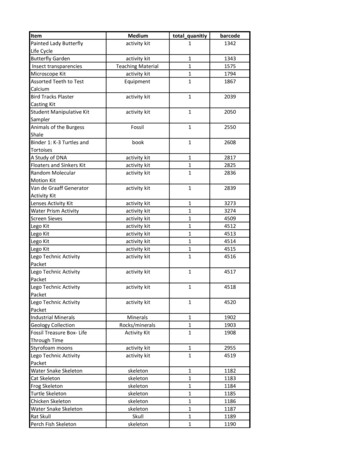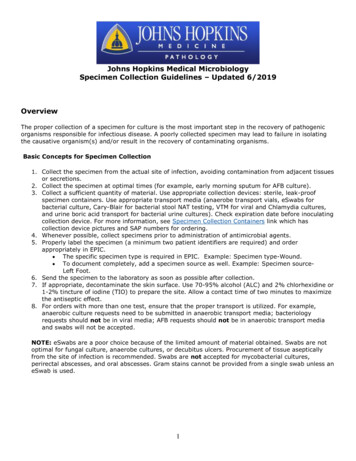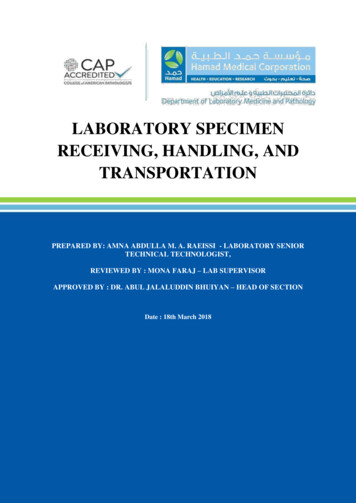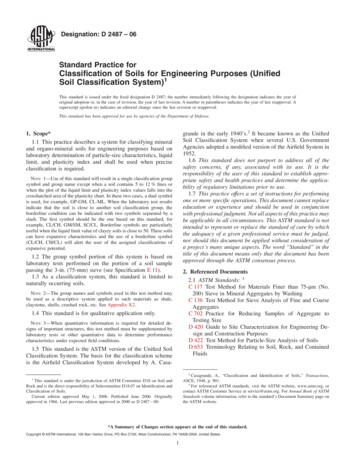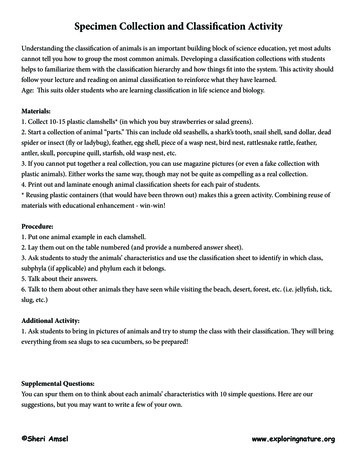
Transcription
Specimen Collection and Classification ActivityUnderstanding the classification of animals is an important building block of science education, yet most adultscannot tell you how to group the most common animals. Developing a classification collections with studentshelps to familiarize them with the classification hierarchy and how things fit into the system. This activity shouldfollow your lecture and reading on animal classification to reinforce what they have learned.Age: This suits older students who are learning classification in life science and biology.Materials:1. Collect 10-15 plastic clamshells* (in which you buy strawberries or salad greens).2. Start a collection of animal “parts.” This can include old seashells, a shark’s tooth, snail shell, sand dollar, deadspider or insect (fly or ladybug), feather, egg shell, piece of a wasp nest, bird nest, rattlesnake rattle, feather,antler, skull, porcupine quill, starfish, old wasp nest, etc.3. If you cannot put together a real collection, you can use magazine pictures (or even a fake collection withplastic animals). Either works the same way, though may not be quite as compelling as a real collection.4. Print out and laminate enough animal classification sheets for each pair of students.* Reusing plastic containers (that would have been thrown out) makes this a green activity. Combining reuse ofmaterials with educational enhancement - win-win!Procedure:1. Put one animal example in each clamshell.2. Lay them out on the table numbered (and provide a numbered answer sheet).3. Ask students to study the animals’ characteristics and use the classification sheet to identify in which class,subphyla (if applicable) and phylum each it belongs.5. Talk about their answers.6. Talk to them about other animals they have seen while visiting the beach, desert, forest, etc. (i.e. jellyfish, tick,slug, etc.)Additional Activity:1. Ask students to bring in pictures of animals and try to stump the class with their classification. They will bringeverything from sea slugs to sea cucumbers, so be prepared!Supplemental Questions:You can spur them on to think about each animals’ characteristics with 10 simple questions. Here are oursuggestions, but you may want to write a few of your own. Sheri Amselwww.exploringnature.org
Specimen Collection and Classification ActivitySupplementary Questions1. Does this specimen represent an animal that has a backbone (Phylum Chordata)?2. Does this specimen represent an animal that has an exoskeleton (Phylum Arthropoda)?3. Does this specimen represent an animal that is worm-shaped and segmented (Phylum Annelida)?4. Does this specimen represent an ocean animal that consumes food though an opening underneath it and has asymmetrical body shape (Phyla Echinoderm or Cnidaria)?5. Does this specimen represent an animal that is soft-bodied but lives inside a shell or has a defensive beak(Phylum Mollusca)?6. Does this specimen represent an animal that has 6 legs or more? (Class Insecta or Arachnid or SubPhylumCrustacean, etc.)?7. Does this specimen represent an animal that has feathers, a shell, scales, fins, etc. (Class Aves, Reptilia, BonyFish, Cartilagenous Fish)?8. Does this specimen represent an animal that has a backbone, is warm-blooded and has fur (Class Mammalia)?9. Does this specimen represent an animal that has a backbone and lays eggs in the water (Class Amphibia)?10. Does this specimen represent an animal that has two matching shells or one spiral shell (Class Bivalve vs.Gastropoda)? Sheri Amselwww.exploringnature.org
Specimen Collection and Classification Answer SheetTo which Phylum, Subphylum, Class, Order or Family does this specimen .19.20. Sheri Amselwww.exploringnature.org
AnimalNematodaArthropoda Platyhelminthes Chordata biataeVertebrataReptilesBirdsBony FishCartilagenous FishCoral,AnemonesLampreysHagfishOysters, Snails, Squid,Clams Slugs, OctopiPeriwinkleswww.exploringnature.orgMammals Sheri AmselVertebrateClass AmphibiansSpiders, Crabs, Barnacles Insects Centipedes MillipedesStarfish Sea Urchins, JellyfishHorseshoe Scorpions Lobsters,Sand DollarsCrabsShrimpInvertebrateClassesSubphyla CheliceratesVertebrata(Segmented (Round Worms)(Flat Worms)(Sponges) (Starfish & Sea Urchins) (Coral & Jellyfish) (Snails, Clams,Worms) Octopi)Phyla AnnelidaThe Animal Kingdom
Sheri Amselwww.exploringnature.org
spider or insect (fly or ladybug), feather, egg shell, piece of a wasp nest, bird nest, rattlesnake rattle, feather, antler, skull, porcupine quill, starfish, old wasp nest, etc. 3. If you cannot put together a real collection, you can use magazine pictures (or even a fake collection with plastic animals).
